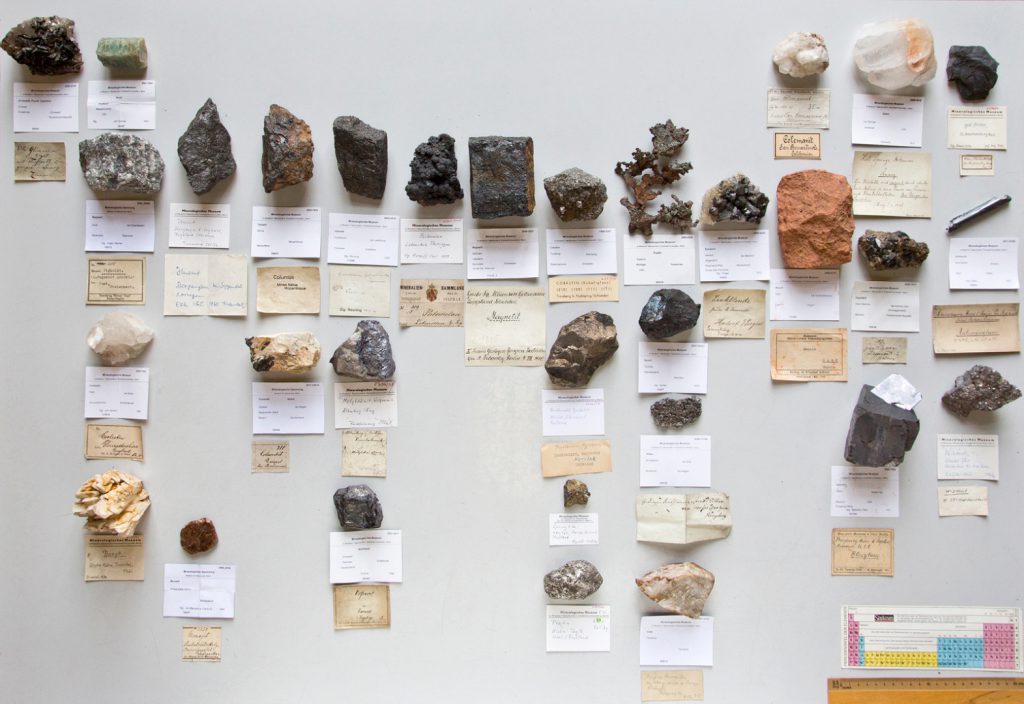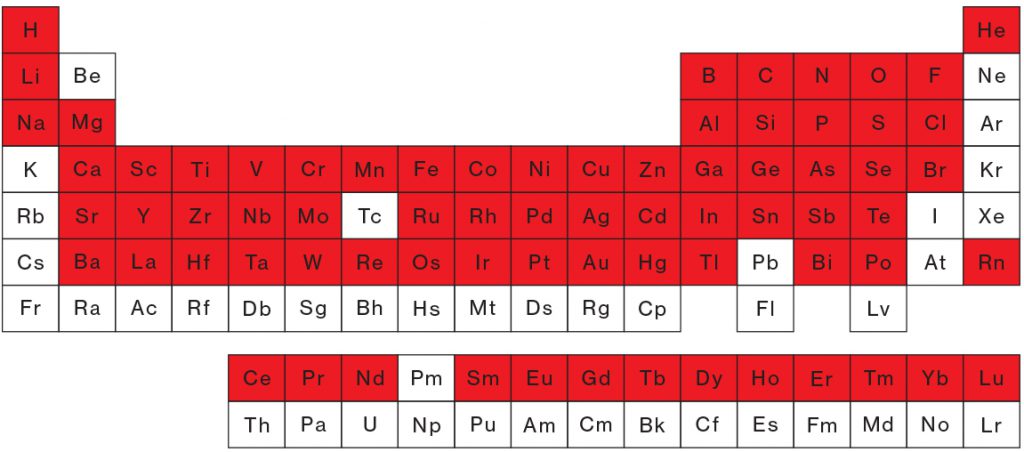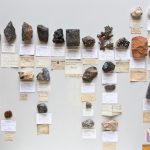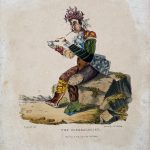Technologies of Romance: Mineralogy: a digital account
Article DOI: https://dx.doi.org/10.15180/191212
Abstract
This article examines the digital media revolution as a revolution reliant upon a sustained legacy of colonial violence in regions such as the Congo, the locale of this study. Contemporary production is foreshadowed by the industrial genocide of the late nineteenth and early twentieth centuries visited upon the Congo by Belgium. In an era defined by globally distributed trade networks, colonialism is equally distributed and mercurial – its complex supply chains obfuscating responsibility toward either the environment or its human inhabitants.
The paper looks at the minerals required for latter day digital devices which have become the latest iteration of conflict in the region. Minerals are traced through a number of modern technologies including matches, atomic clocks and mobile devices, all of which evoke alchemical transformation and spectacle. We trace the legacy of colonial violence through smartphones, as the contemporary epitome of technical supremacy – highlighting their qualities of immediacy, mobility and making the remote proximate, especially by bringing remotely sourced geological elements into everyday use. Moving away from our own techno-romantic affiliation with such commodities, the article highlights the fact that focus on effect often further obfuscates the causal factors and consequences of resource extraction in commodity production. Even as we summon stories of global trade with our fingertips on mobile, networked devices, we are implicated in these cycles of violence.
Keywords
colonialism, conflict minerals, Congo, digital technology, mineralogy, mobile phone
Introduction
https://dx.doi.org/10.15180/‘We are walking talking minerals’ (Margulis and Sagan, 2000, 49).

‘These 31 rock samples come from the mineralogy collection of the Museum für Naturkunde Berlin… They represent the earthly substrates which make our…digital world possible.’[1]
The ‘handset’; the ‘handy’; the ‘mobile’; the ‘smartphone’. However we refer to our hand-held digital devices, the terms tend to evoke the mobility of the hand in bringing what is remote into close proximity. Even the term ‘device’ can be used to refer to a sleight of hand and the capacity of the nimble fingered to dissimulate and deceive. This paper considers the mobile device as exactly that, and as a form of mobility that also evinces forms of immobility, particularly in terms of the exploited peoples and resources necessary to produce them. We consider the mobile device as the true recipient of our global communication networks; mediator of our declarations of love and of our despair. What does it mean to convey the range of human affect through these technical appendages? What do they say for us and of us? I will suggest that the digital revolution has been, and is, reliant upon a legacy of violent expropriation that reiterates racist and classist attitudes, even as western academies purport to a project of ‘decolonisation’ and of making reparations to victims of the slave trade. This past week has seen Glasgow University seeking to pay reparations of £20 million pounds for victims of the European slave trade that fuelled the industrial production of raw materials (Carrell, 2019). In collaboration with the University of the West Indies, the university signed a memorandum of understanding, leading to a sense that slavery is a thing of the past.
The particular labour practices analysed in this paper are the mining of conflict minerals in the Congo. We will see that while this labour may be distinguished from colonial slavery in that it is not ‘forced’ in quite the same manner, the violence of multi-national corporations ensure that it retains many of the same characteristics. I explore relative aspects of mobility and remoteness through the mobile device, particularly the smartphone. We will see that the spectacle and effect of technical supremacy still manage to efface the ethics of production in the manufacturing of technics. Production features, as well as their consequences, are often suppressed in technical accounts in favour of spectacle, effacing cycles of violent appropriation. Furthermore, the article begins by suggesting that indigenous approaches to technological artefacts can help us approach technology with greater insight and an insistence upon material causality that might extend to global trade networks.
I: Flames from their fingertips
https://dx.doi.org/10.15180/191212/002On Bougainville Island, the great-grandmother of a colleague was pointed out to me. Miley was over a hundred years old and could recall the first white missionaries who had come to the island. Perhaps for this reason, she refused to speak to whites. Her great-grandson relayed the story that the missionaries were believed to procure fire from their fingertips. From this perspective, the matches that the missionaries struck were incidental to the effects of fire that were clearly the result of intentional physical and chemical reactions located in the bodies of those who produced them. While this idea may at first seem counter intuitive, its material logic places emphasis on cause rather than effect, reminding us that such an act does indeed require certain physical and chemical changes in the body of the user.

The spectacle of a lit match to those who have no previous knowledge of such an object might undoubtedly evince a weird magic, contributing to the authority of the missionary project and its ‘civilising’ remit. While the Bougainvillian woman had clearly never been exposed to the manufacturing or scientific basis of the match, it seems even more strange that those of us who have fire at our fingertips every day are no more informed about the complex chain of physical causality that make such ghostly procurements possible. For example, the technology of the match was a long time in progress. Early chemical matches were too dangerous to reach mass use or production and it was only with the use of the chemical element phosphorous that industrial scale production of matches was realised (Wisniak, 2005, p 370). Phosphorous is a chemical element essential to all life while being highly reactive in isolation (Chun and Kindel, 2019). It is distributed in minerals as phosphates and was first extracted from human urine samples by Brandt in 1669, later manufactured commercially from concentrated animal bone (Hughes et al, 1962, p 84). Today, it is mined from phosphate rock (ibid). Match heads require oxidisable matter in order to catch light, and in their initial manufacture it was the pyrophoric white (sometimes ‘yellow’) phosphorous that seemed most suitable (Barnett, 1919, p 163). However, white phosphorous soon became associated with phosphorous necrosis of the jaw, or phossy jaw, ‘the most terrible of the industrial diseases’ (Hughes et al, 1962, p 83). The fumes of white phosphorous were gradually understood to corrode the gums and loosen teeth, eventually to ‘denude’ the jaw bone which, with ‘fetid suppuration’, would come away from the skull (ibid, 88). The disease led to permanent disfigurement and, in twenty per cent of cases, death (ibid, 83). Bearing such indirect chemical reactions in mind, it is hardly a leap to imagine that flames might issue from the tips of fingers.
Today, it is not just fire, but the world as information that is procured through the intentional physical and chemical reactions of our own bodies, as well as the bodies of an invisible workforce. Let us first consider some of today’s smartphone touchscreen technology from the vantage of such magic, where the user’s body is instrumental in the production of an electric circuit. Indeed, through the touchscreen, the notion of our fingertips procuring flickering images becomes a literal case in point. Capacitive touchscreens are also capacitators, which means they are electrical circuits that store electricity, composed of two conductive electrodes and separated by an insulating gap (Rohig, 2015). In order to conduct electricity, the glass screen is coated with a transparent layer of conductive substance – usually the chemical element indium tin oxide – forming a grid which stores a small electrical charge (ibid). Indium tin oxide is a composition comprising chemical elements oxygen, indium and tin, the latter two being also metals. When pressed by a finger, the screen’s voltage drops at the point of pressure and a tiny amount of electrical charge enters the finger, due in part to a combination of moisture and salt in the skin allowing it to conduct electricity (ibid). By holding the device with our other hand, the electrical circuit is complete, looping to its back, which is electrically grounded (Saini, 2011). In short, we complete the electric circuit by conducting electrical current. The tips of our fingers procure not only fire, but electrical current enough to summon entire networks of global information. In so doing, they evince a spectacle of alchemical supremacy that appears to efface their violent and unethical supply chain.
II: Extraction
https://dx.doi.org/10.15180/191212/003The technical apparatus discussed above rely upon chemical elements extracted from the Earth, as well as from gas, and from our own bodies to articulate them. The fact that the West’s major technical epochs have been birthed from the ingenious use of the Earth’s crust can be difficult to hold in our minds. Carboniferous fossil fuels are the result of geological processes that were activated by organic matter hundreds of millions of years ago. The tapping and mining of resulting deposits such as crude oil and coal, as well as the extraction of minerals and metals from ore, facilitated our first major industrial revolution in the nineteenth century. The vast networks of production that would mechanise systems of labour, communication and transport required a vast restructuring of land and peoples. For centuries, it seemed that a few sovereign nations would continue to benefit from exploiting the Earth’s resources and the populations procuring them, for little or no return. One example of this is the systematic harvesting of rubber from the Democratic Republic of the Congo (DRC), noted by John Tully as a commodity upon which modern warfare was dependent (2011, p 17). The structure of industrial production was evoked by one author as a living being, whose very muscles and sinews were made out of rubber (Litchfield in Tully, 2011, p 17). When British missionary Alice Seely Harris first photographed brutalised Congolese workers on European rubber plantations in the early twentieth century, her images became part of two contested legacies: one which documented unquestionable imperial violence in magic lantern slide shows that toured Europe. The other, as part of the imperial project that inadvertently reiterated white supremacy, invoking Christian salvation by the same means (see Hasian, 2015; and Sealy 2019). This period in the Congo is infamous for its industrial genocide under the colonial rule of King Leopold II. It is estimated that ten million Congolese were murdered under Leopold’s regime (ibid, 189; Hoschild, 1998, pp 3, 280). Seely Harris’ images have haunted me since I first saw them; the image of Nsala, gazing at the severed hand and foot of his daughter is like an analogue of all those erased by western technical epochs – a body reduced to the sum of its parts, abstracted and discarded. Hands were removed and collected at the behest of the colonial authority, each representing a cartridge used to execute those demonstrating resistance to forced labour. This was considered an index of appropriate use, where bullets were otherwise likely to be squandered on hunting or attempted mutiny (Hoschild, 1998, p 165). Where the hand could not be forced to work, it could be literally held to account for bullets used by the occupying force. We know from the photographs of Seely Harris that in many cases, hands were also removed from the living in order to balance the accounts. In the next section we will consider how practices such as ‘artisanal mining’ evoke the hand in new forms of colonial servitude.

III: Mineral
https://dx.doi.org/10.15180/191212/004Just as the industrial revolution was reliant upon the systematic extraction of goods from overseas such as rubber, sugar, cotton, tobacco and oil, so the digital revolution has been reliant upon the global extraction and supply of rare earth metals from minerals. The average smartphone contains two-thirds of the elements listed on the Periodic Table, approximately 75 elements (Kakaes, 2016). Minerals are physical matter that problematise the easy association of the organic with nature. According to the International Council on Mining and Metals (ICMM), minerals are ‘solid, naturally occurring inorganic substances that can be found in the Earth’s crust. They are formed without the intervention of humans and have a definite chemical composition and crystal structure’ (ICMM, 2019). Metals are distinguishable from minerals, being ‘elementary substances…that are crystalline when solid and naturally occurring in minerals’ (ibid). Metals can be sorted into sub-categories: ferrous; non-ferrous; alloy; precious; base; and rare – termed ‘rare’ due to the difficulty in extracting them from the Earth’s crust (ICMM, 2019; King, 2019). In recent years, rare metals have come to underpin entire industries. Our electronic devices, computer memory, smartphones, rechargeable batteries, military defences, GPS systems and smartphone apps are examples of goods reliant upon rare metals.
Many rare earth metals are dubbed ‘conflict metals’ – mined in regions of conflict that are often former colonies. Perhaps most notorious is the DRC, where militias use forced labour and violence to procure mineral wealth from tin, tantalum, cobalt, tungsten and gold. It is estimated that the DRC contains 24 trillion dollars-worth of minerals, even as it remains one of the poorest and most conflict-ridden regions on Earth (Aljazeera, 2016). The history of colonial interest in DRC and its continued exploitation since the sixteenth century has left a legacy of systemic corruption and violence, much in evidence today. Some argue that even the history of documenting these atrocities benefits the West, creating an economy of images that have been instrumental in preventing structural justice (Jacobs, 2010).
The Congo produces over half of the world’s cobalt, used in rechargeable lithium-ion batteries that power laptops, smartphones, electric car batteries, as well as being used in food preservatives and prostheses (Amnesty, 2016, p 15) Scheele et al, 2016, p 39). Its use in super alloys for jet engines mean it is classified as a ‘strategic metal’ (Amnesty, (2016, p 18) (Scheele et al, 2016, p 39). It is estimated that twenty per cent of the total cobalt is mined by ‘artisanal miners’ – a cryptic way of referring to those who mine using hand tools in unregulated mines, without protective equipment (Amnesty, 2016, p 18). These workers – sometimes children – are prone to exploitation by corrupt government security forces, despite the unofficial status of the mines, or by traders who claim to purchase mined goods by weight (ibid 5; 8; 13). As one report claims: ‘The government […] needs to address the complicity of officials who turn a blind eye to the dangerous conditions in which many artisanal miners work while still extorting illegal payments from them’ (ibid, 36). In the Congolese town of Kasulo, there are reports of people mining further than thirty metres beneath their own homes following the seam of metal ore, devising dangerous makeshift shafts with only mallets and chisels (ibid 20; 21).
In a documentary by Frank Poulson (2010), the film-maker traces the components of his Nokia phone to the heavily guarded Cassiterite mine in Bisie, DRC. At one point, he and his camera operator descend into the mine shaft, filming young artisanal miners prising rock from the façade with hand tools. The film-makers are met angrily by those who do not want their identities and already precarious forms of labour further threatened by a white interloper making excavations with his camera. Such image capture reiterates an already unbearable set of circumstances in which some are given no choice but to remain subject to western interests.
Where mining is organised, conditions barely improve for local communities. Today, the aptly named Frontier Mine continues to evoke the supposed heroism of colonial exploration. Owned by the Eurasian Resources Group (ERG, formerly ENRC), the copper and cobalt producing site in Katanga DRC has displaced entire communities in order to expand its mining facility. In being ‘resettled’, communities have been promised new schools, fresh drinking water and housing, much of which has never materialised (Verweij, 2016). Where housing has been erected, it declines rapidly due to exceptionally poor quality and lack of suitability for the terrain (ibid). While mining facilities often pollute natural water resources, the provision of wells and water tanks require regular maintenance, creating a dependence upon the mining companies (see Scheele et al, 2016, p 34). ERG’s website proclaims itself ‘the vanguard of globalisation’, making claims to sustainability and human rights in its code of conduct that do not equate with the reported reality of its large-scale enterprises (ERG a; ERG b). The company was reprivatised in 2013 after a number of scandals regarding corruption and legal disputes that saw it removed from the London Stock Exchange (Scheele et al, 2016, p 14). ERG is the main shareholder not only of Frontier, but Boss Mining and Comide, in which Gécamines, DRC’s state-owned mines, has shares of no more than thirty per cent (ibid, 12). Registered in Luxembourg, ERG is actually located in Kazakhstan, forty per cent owned by the Kazakh government (ibid, 15). However, the Netherlands also has a significant position in the company’s business structure: Boss Mining, Frontier and Comide are all subsidiaries of the Dutch Eurasian Resources group BV (ibid, 15). This complex structure ensures that legal disputes regarding human rights abuses take years to resolve due to a lack of clear accountability. In a complaint filed by Rights and Accountability in Development (RAID) and Action Contre l’impunite pour les Droits Humains (ACIDH)[2], the UK government’s Department of Business, Innovation and Skills found the company guilty of failing to meet human rights standards, failing to address the impacts of mining on local communities, and neglecting to provide access to safe drinking water – itself a human right (Raid, 2016).
Furthermore, in a report by Stichting Onderzoek Multinationale Ondernemingen (SOMO),[3] some 430 hectares of agricultural land owned by six hundred farmers, are said to have been expropriated by Frontier, without consultation, a direct contravention of Congolese mining law (Scheele et al, 2016, pp 28, 30). As a consequence, many farmers have fallen into extreme poverty (ibid).
These examples begin to illustrate how the Congo still provides the West with a vast source of wealth, whilst the Congolese are denied rights over land, body or image. Just as human life here is reduced to a raw material, raw materials themselves are considered inert matter, to be translated into a series of technical resources that have no other purpose than to facilitate technical empires whose products are built upon rapid obsolescence. For the consumers of these devices, the seduction of surface-effect, as well as the convenience of a globally connective network, have served to dispense with notions of causality, obfuscating both chains of production and corporate responsibility.
IV: Mineral time: conclusion
https://dx.doi.org/10.15180/191212/005Almost 25 years ago, hand surgeon Robert Markison quipped that we have ‘enslaved the hand to data’ (McCarthy, 1995). As ‘hand-intensive primates’, computer keyboard and mouse were considered by Markison to be disrespectful to the hand, devolving us to inert ‘lizard-like creature(s) splayed flat on a keyboard’ (ibid). This reference frames the current phase of western evolution as ‘de-evolution’: a regression evoking our distant reptilian past, even in light of the burgeoning complexity at our keyboard-splayed fingertips. The hand that is today enslaved by data might serve to remind us of those whose enforced labour demonstrates capitalism’s continued reliance upon forms of more or less violent subjugation and enslavement. Certain human subjects long preceded capitalism as proto-commodities, traded between men of privilege. Lives sold into slavery were already forms of currency and property whose rights were overwritten to provide the contractual bonds between men of private means. Today, in keeping with this logic, the hi-tech gadgets that summon the world to our fingertips appear more animate and lively than the complex network of human labour that bring them into being.[4] After all, it is the gadget, and not the social world, that comes to rest in the palm of one’s hand.
Making causal links between the hand-held device and supply chains that reiterate colonial history remind us that colonialism and forms of slavery are far from aspects of the distant past. The current technical era is characterised by hand-held electronics powered by rare earth metals, mined in some of the most contested sites on earth by workers who see nothing of the vast profit their labour creates. Reflecting on mineral wealth, it is interesting to consider that time itself is now measured according to mineral elements. Since 1968, the international system of units (SI) has defined a second as a duration of nine billion, one hundred and ninety-two million, six hundred and thirty-one thousand, seven hundred and seventy cycles of radiation that correspond to the transition between two energy levels of the ground state of the caesium-133 atom (SI, p 169). Caesium is an alkali metal that is largely mined from the zeolite mineral, Pollucite. Each billionth teems with possibility while alluding to the sluggish metabolism of the human animal whose own ‘time’ is increasingly understood at the geologic scale through fashionable neologisms like the ‘Anthropocene’. Today, it is possible to suggest that we live by mineral time – a time of extraction and compression; a time of finite deposits, activated in devices that press urgently against the palm of the hand. It remains to be seen whether this urgency will be answered by those who should take the call.
Tags
Footnotes
Back to text
Back to text
Back to text
Back to text





